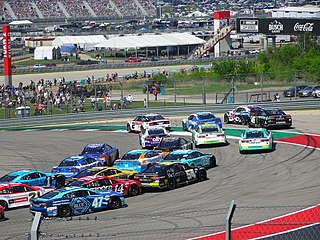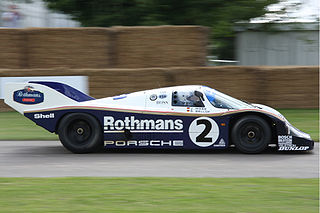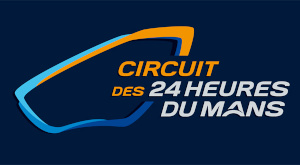
Auto racing is a motorsport involving the racing of automobiles for competition. In North America, the term is commonly used to describe all forms of automobile sport including non-racing disciplines.

An open-wheel car is a car with the wheels outside the car's main body, and usually having only one seat. Open-wheel cars contrast with street cars, sports cars, stock cars, and touring cars, which have their wheels below the body or inside fenders. Open-wheel cars are built both for road racing and oval track racing. Open-wheel cars licensed for use on public roads, such as the Ariel Atom, are uncommon, as they are often impractical for everyday use.

Silverstone Circuit is a motor racing circuit in England, near the Northamptonshire villages of Silverstone and Whittlebury. It is the home of the British Grand Prix, which it first hosted as the 1948 British Grand Prix. The 1950 British Grand Prix at Silverstone was the first race in the newly created World Championship of Drivers. The race rotated between Silverstone, Aintree and Brands Hatch from 1955 to 1986, but settled permanently at the Silverstone track in 1987. The circuit also hosts the British round of the MotoGP series.
A Formula One car or F1 car is a single-seat, open-cockpit, open-wheel formula racing car with substantial front and rear wings, and an engine positioned behind the driver, intended to be used in competition at Formula One racing events. The regulations governing the cars are unique to the championship and specify that cars must be constructed by the racing teams themselves, though the design and manufacture can be outsourced. Formula One drivers experience peak cornering forces of up to six lateral g.

The Circuit de Spa-Francorchamps, informally referred to as Spa, is a 7.004 km (4.352 mi) motor-racing circuit located in Francorchamps, Stavelot, Wallonia, Belgium, about 8 km (5.0 mi) southeast of Spa. It is the current venue of the Formula One Belgian Grand Prix, hosting its first Grand Prix in 1925, and has held a Grand Prix every year since 1985 except 2003 and 2006.

The Shanghai International Circuit, also called the Shanghai Audi International Circuit for sponsorship purposes, is a motorsport race track, situated in the Jiading District, Shanghai, China. The circuit is best known as the venue for the annual Chinese Grand Prix which was hosted from 2004 to 2019, and from 2024.

Brands Hatch is a motor racing circuit in West Kingsdown, Kent, England, United Kingdom. Originally used as a grasstrack motorcycle circuit on farmland, it hosted 12 runnings of the British Grand Prix between 1964 and 1986 and currently hosts many British and International racing events. The venue is owned and operated by Jonathan Palmer's MotorSport Vision organisation.

The Porsche 917 is a sports prototype race car developed by German manufacturer Porsche to exploit the regulations regarding the construction of 5-litre sports cars. Powered by a Type 912 flat-12 engine which was progressively enlarged from 4.5 to 5.0 litres, the 917 was introduced in 1969 and initially proved unwieldy on the race track but continuous development improved the handling and it went on to dominate sports-car racing in 1970 and 1971. In 1970 it gave Porsche its first overall win at the 24 Hours of Le Mans, a feat it would repeat in 1971. It would be chiefly responsible for Porsche winning the International Championship for Makes in 1970 and 1971. Porsche went on to develop the 917 for Can-Am racing, culminating in the twin-turbocharged 917/30 which was even more dominant in the role. Porsche drivers would win the Can-Am championship in 1972 and 1973. 917 drivers also won the Interserie championship every year from 1969 to 1975.

Jochen Richard Mass is a German former racing driver.

The 24 Hours of Le Mans is an endurance-focused sports car race held annually near the town of Le Mans, France. It is widely considered to be one of the world's most prestigious races, and is one of the races—along with the Monaco Grand Prix and Indianapolis 500—that form the Triple Crown of Motorsport, and is also one of the races alongside the 24 Hours of Daytona and 12 Hours of Sebring that make up the informal Triple Crown of endurance racing. Run since 1923, it is the oldest active endurance racing event in the world.

The Porsche 956 was a Group C sports-prototype racing car designed by Norbert Singer and built by Porsche in 1982 for the FIA World Sportscar Championship. It was later upgraded to the 956B in 1984. In 1983, driven by Stefan Bellof, this car established a record that would stand for 35 years, lapping the famed 20.832 km (12.93 mi) Nürburgring Nordschleife in 6:11.13 during qualifying for the 1000 km Sports Car race. The record was finally surpassed by Timo Bernhard in a derestricted Porsche 919 Evo on 29 June 2018.

The Circuit des 24 Heures du Mans, also known as Circuit de la Sarthe located in Le Mans, Sarthe, France, is a semi-permanent motorsport race course, chiefly known as the venue for the 24 Hours of Le Mans auto race. Comprising private, race-specific sections of track in addition to public roads which remain accessible most of the year, its present configuration is 13.626 km (8.467 mi) long, making it one of the longest circuits in the world. The capacity of the race stadium, where the short Bugatti Circuit is situated, is 100,000. The Musée des 24 Heures du Mans is a motorsport museum located at the main entrance of the venue.

Mallory Park is a motor racing circuit situated in the village of Kirkby Mallory, just off the A47, between Leicester and Hinckley, in central England. Originally used for grass-track until 1955, a new, basically oval hard-surfaced course was constructed for 1956, with a later extension forming a loop with a hairpin bend.
The International Sporting Code (ISC) is a set of rules applicable to all four-wheel motorsport as governed by the Fédération Internationale de l'Automobile (FIA). It was first implemented in 1926.

The 1950 24 Hours of Le Mans was a motor race for sports cars, staged at the Circuit de la Sarthe, Le Mans, France on 24 and 25 June 1950. It was the 18th Grand Prix of Endurance. The race was won by the French father-and-son pairing of Louis and Jean-Louis Rosier driving a privately entered Talbot-Lago.

The 1949 24 Hours of Le Mans was the 17th Grand Prix of Endurance, and took place on 25 and 26 June 1949. Luigi Chinetti won the race for a third time in the first Ferrari barchetta by driving 22.5 hours. This race also saw the death of British driver Pierre Maréchal when his Aston Martin DB2 was involved in an accident between Arnage and Maison Blanche around 1:00 a.m. Marechal had attempted to pass another car there and he hit an embankment and the hapless Briton was crushed by the overturning car.
The 1926 24 Hours of Le Mans was the 4th Grand Prix of Endurance, and took place on 12 and 13 June 1926. It was the first Le Mans race where the winner's average speed was over 100 km/h (62 mph), and also the first to break the 24-hour distance record set by Selwyn Edge at Brooklands in 1907.

The Bristol 450 was a successful sports car racing prototype model, designed in 1953 by Bristol Cars and based on the abortive ERA G-type Formula Two car of 1952. Although most sources state that only three 450s were built, photographic evidence suggests that at least four were in existence at one point in time. The cars were constructed specifically to contest the prestigious 24 Hours of Le Mans endurance race, at which they won both their class and the team prize in both 1954 and 1955. In addition to its race victories, the Bristol 450 also took a number of outright speed records for the 2-litre class during trials at the Montlhéry circuit in 1953. Following the 1955 Le Mans disaster, which killed Pierre Levegh and 83 spectators, Bristol withdrew from direct involvement in motorsport and all but one of the 450s were broken up.

The Race of Two Worlds, also known as the 500 Miglia di Monza, was an automobile race held at the Autodromo Nazionale Monza, Italy in 1957 and again in 1958. It was intended as an exhibition event, allowing American teams from the United States Auto Club (USAC) National Championship to compete directly against teams from the Formula One World Championship based in Europe. The two types of cars competed on the banked oval at Monza which had been completed in 1955. Due to the similarity to the Indianapolis Motor Speedway, where the USAC teams ran the Indianapolis 500, the event earned the nickname Monzanapolis.

Electric motorsport is a category of motor sport that consists of the racing of electric powered vehicles for competition, either in all-electric series, or in open-series against vehicles with different powertrains. Very early in the history of automobiles, electric cars held several performance records over internal combustion engine cars, such as land speed records, but fell behind in performance during the first decade of the 20th century.















